The Excitation of Ultrasound by Laser Radiation in Water Using an Optical Fiber Laser Converter with a 2D Colloidal Crystalline Coating
Abstract
1. Introduction
2. Experimental Setup
3. Converter with a Coating of Focusing Spheres
4. Experimental Results
5. Discussion of Results
5.1. Focusing: Single Sphere
5.2. Diffraction on 2D Spheres Monolayer in Water
5.3. Generation of Ultrasound
- A significant increase in the level of ultrasound intensity (up to 20 dB) in the range of 0.5–4 MHz.
- In experiments without coating, radiation with peaks of 0.25 and 0.75 MHz prevails. The same radiation is present in experiments with the coating too.
- When applying coatings, there appears an OA response with peaks in the 1–4 MHz range and with the amplitude comparable to that of the radiation in the region up to 1 MHz.
6. Conclusions
- The technology of applying a colloidal single-layer coating of transparent PS Ø 1 μm spheres at the end face of a quartz fiber has been proposed and tested. Such a coating plays the role of a converter of pulsed laser radiation into acoustic radiation in a light absorbing liquid.
- When excited by laser radiation, the microspheres produce in the liquid laser jets which interfere and give a regular spatial structure in a laser beam consisting of “pellets” with high intensity and with a diameter of a fraction of a micron and a length of several microns.
- In pure water at λ = 1.064 μm (light absorption ~ 0.1 cm−1), a thermal microstructure is formed with a characteristic size of fractions of ~λ, a maximum temperature up to 10−2 degree at an energy of a short laser pulse of ~0.005 J. The developed equipment allows accurate recording of ultrasound generation with expected microheating.
- A significant difference between the generation of ultrasound upon excitation in water by laser radiation through an uncoated optical fiber and with a 2D colloidal coating was found experimentally. The ultrasound spectrum in the latter case was enriched in frequency to 1–4 MHz and increased in amplitude by ~20 dB. The mechanism of such a drastic change is still unclear.
Author Contributions
Funding
Acknowledgments
Conflicts of Interest
References
- Beard, P. Biomedical photoacoustic imaging. Interface Focus 2011, 1, 602–631. [Google Scholar] [CrossRef] [PubMed]
- Schnell, C. Imaging: Gas vesicles enable ultrasound imaging. Nat. Methods 2018, 15, 159. [Google Scholar] [CrossRef]
- Subochev, P.; Katichev, A.; Morozov, A.; Orlova, A.; Kamensky, V.; Turchin, I. Simultaneous photoacoustic and optically mediated ultrasound microscopy: Phantom study. Opt. Lett. 2012, 37, 4606–4608. [Google Scholar] [CrossRef] [PubMed]
- Hsieh, B.-Y.; Chen, S.-L.; Ling, T.; Guo, L.J.; Li, P.-C. All-optical scanhead for ultrasound and photoacoustic dual-modality imaging. Opt. Express 2012, 20, 1588. [Google Scholar] [CrossRef]
- Song, W.; Hong, M.; Lukyanchuk, B.; Chong, T. Laser-induced cavitation bubbles for cleaning of solid surfaces. J. Appl. Phys. 2004, 95, 2952–2956. [Google Scholar] [CrossRef]
- Verhaagen, B.; Rivas, D.F. Measuring cavitation and its cleaning effect. Ultrason. Sonochem. 2016, 29, 619–628. [Google Scholar] [CrossRef]
- Chen, Z.; Wu, Y.; Yang, L.; Yang, J.; Xie, B.; Li, X.; Lei, S.; Yang, X.; Zhou, Q.; Zhu, B.; et al. Multilayered carbon nanotube yarn based optoacoustic transducer with high energy conversion efficiency for ultrasound application. Nano Energy 2018, 46, 314–321. [Google Scholar] [CrossRef]
- Scruby, C.B.; Drain, L.E. Laser Ultrasonics Techniques and Applications; Taylor &Francis Group: New York, NY, USA, 1990. [Google Scholar]
- Georg, W.; Pleitez Miguel, A.; Rosenthal, A.; Ntziachristos, V. Looking at Sound: Optoacoustics with all-optical ultrasound detection. Light Sci. Appl. 2018, 7, 53. [Google Scholar] [CrossRef]
- Lyamshev, L.M. Optoacoustic Sources of Sound. Sov. Phys. Uspekhi 1981, 24, 977. [Google Scholar] [CrossRef]
- Lyamshev, L.M. Lasers in acoustics. Sov. Phys. Uspekhi 1987, 30, 252. [Google Scholar] [CrossRef]
- Karabutov, A.A. Laser excitation of surface acoustic waves: A new direction in opto-acoustic spectroscopy of a solid. Sov. Phys. Uspekhi 1985, 28, 1042. [Google Scholar] [CrossRef]
- Bozhkov, A.I.; Bunkin, F.V. Generation of sound in a liquid as a result of absorption of modulated laser radiation. Kvantovaya Elektron. 1975, 2, 176. [Google Scholar] [CrossRef]
- Vladislav, K.; Viacheslav, K.; Vladimir, B.; Alexander, P.; Nikita, B. Use of colloidal single layers of glass spheres for the improvement of the optoacoustic ultrasound generation. Mater. Res. Express 2019, 6, 045201. [Google Scholar] [CrossRef]
- Vladimir, B.; Nikita, B. 2D mesoscale colloidal crystal patterns on polymer substrates. Mater. Res. Express 2018, 5, 055306. [Google Scholar] [CrossRef]
- Bredikhin Vladimir, I. Gaussian beam sphere optics in condensed matter research. Opt. Commun. 2020, 455, 124476. [Google Scholar] [CrossRef]
- Johannes, K.; Nikita, A. Axially symmetric focusing as a cuspoid diffraction catastrophe: Scalar and vector cases and comparison with the theory of mie. Phys. Rev. B 2006, 73, 235401. [Google Scholar] [CrossRef]
- Lu, H.; Yiping, H.; Gerard, G.; Jiajie, W.; Gerard, G. Photonic jet generated by spheroidal particle with gaussian-beam illumination. J. Opt. Soc. Am. B 2014, 31, 1476. [Google Scholar] [CrossRef]
- Stafeev, S.S.; Kozlova, E.S.; Kozlov, D.A.; Morozov, A.A.; Kotlyar, V.V.; Korolyov, S.P. Focusing of continuous and pulsed laser beams by microsphere. Comput. Opt. 2012, 36, 489. (In Russian) [Google Scholar]
- Mitin, N.; Pikulin, A. Generation of photonic vortex lattices with colloidal monolayers of dielectric microparticles. Opt. Lett. 2017, 42, 2527. [Google Scholar] [CrossRef]
- Afanasiev, A.; Bredikhin, V.; Pikulin, A.; Ilyakov, I.; Shishkin, B.; Akhmedzhanov, R.; Bityurin, N. Two-color beam improvement of the colloidal particle lens array assisted surface nanostructuring. Appl. Phys. Lett. 2015, 106, 183102. [Google Scholar] [CrossRef]
- Cullum Brian, M.; Holthoff Ellen, L.; Pellegrino Paul, M. Optical reflection and waveguiding of sound by photo-thermally induced barriers. Opt. Express 2017, 25, 22738–22749. [Google Scholar] [CrossRef] [PubMed]
- Landau, L.D.; Lifshitz, E.M. Course of Theoretical Physics. Fluid Mechanics, 2nd ed.; Butterworth-Heinemann: Oxford, UK, 1987; Volume 6, p. 201. [Google Scholar]
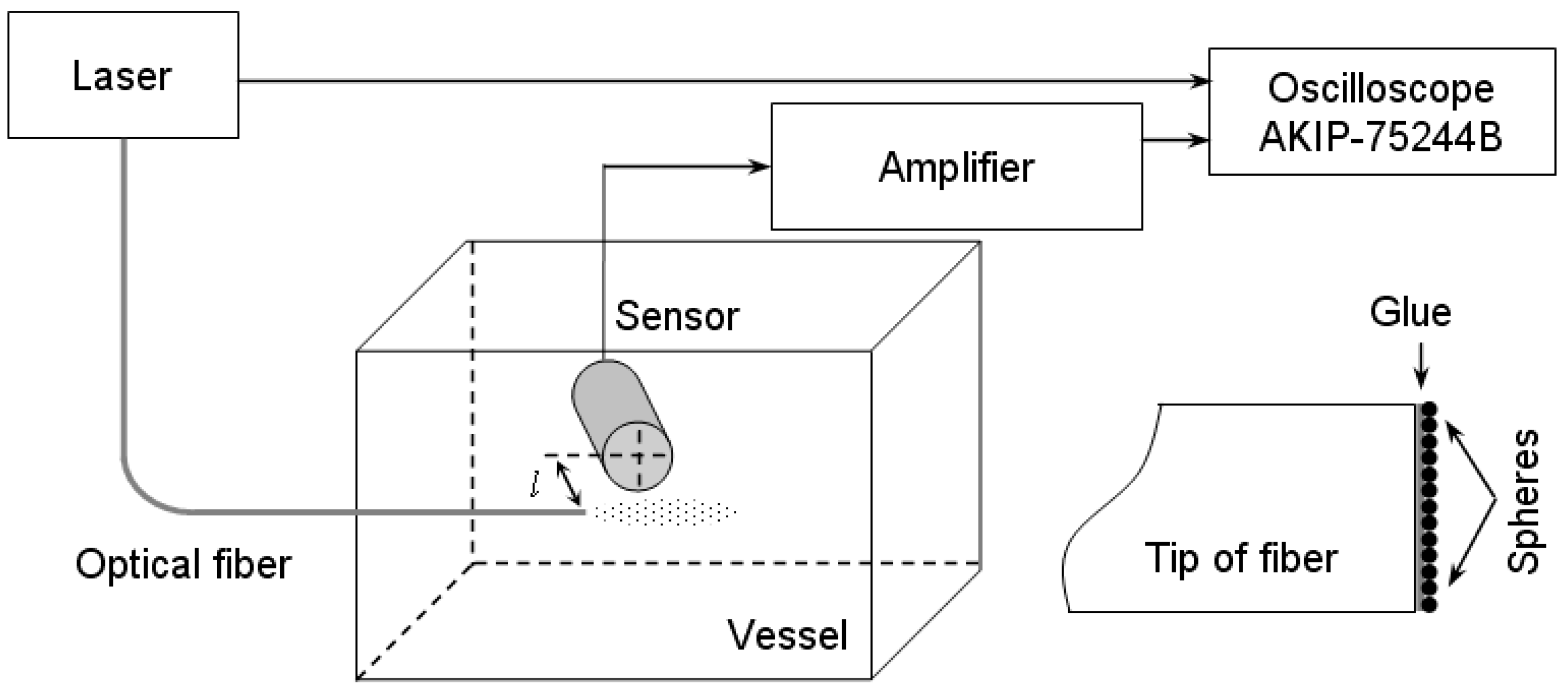
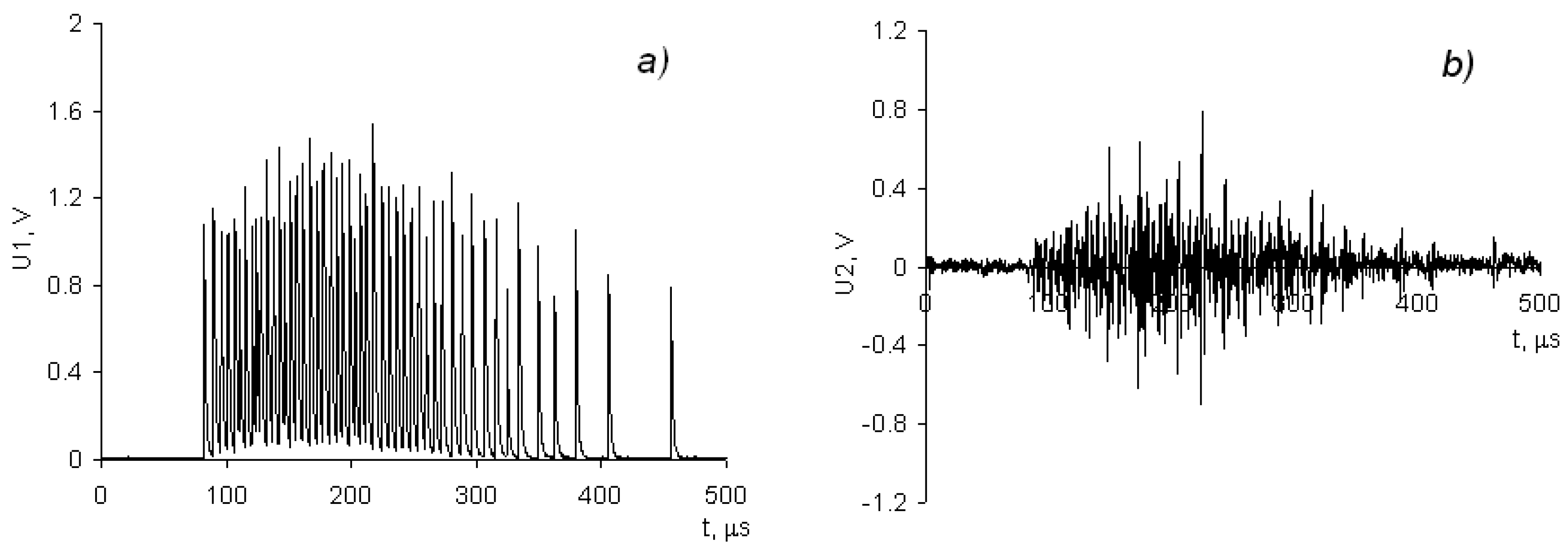

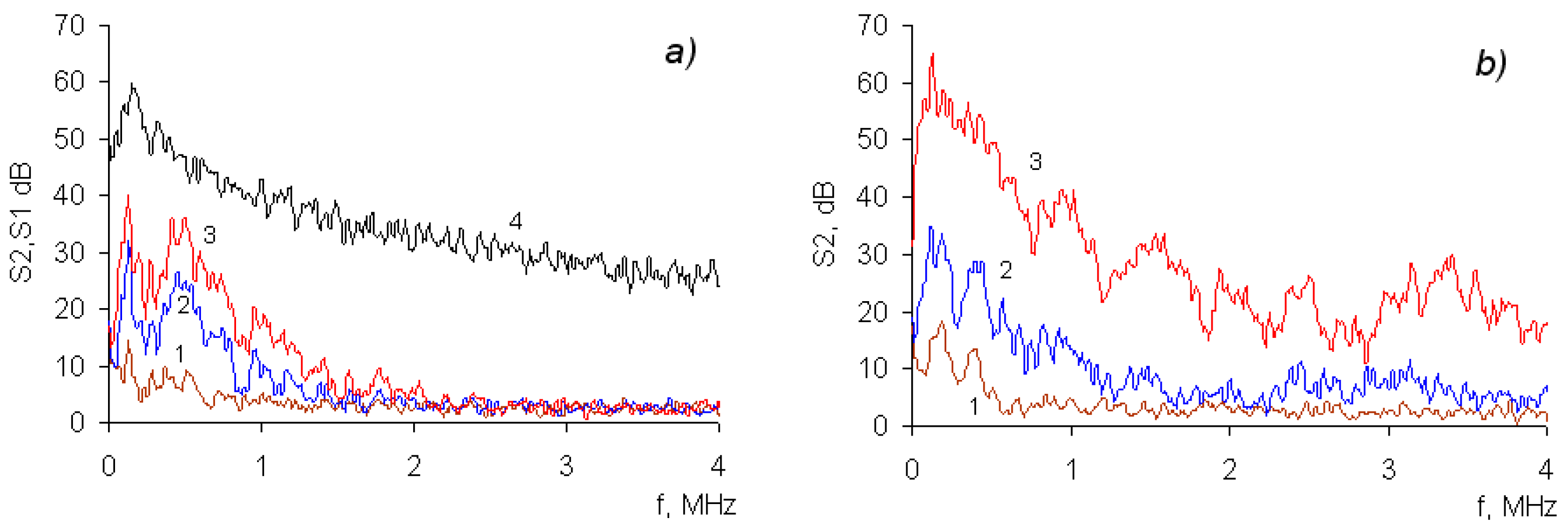
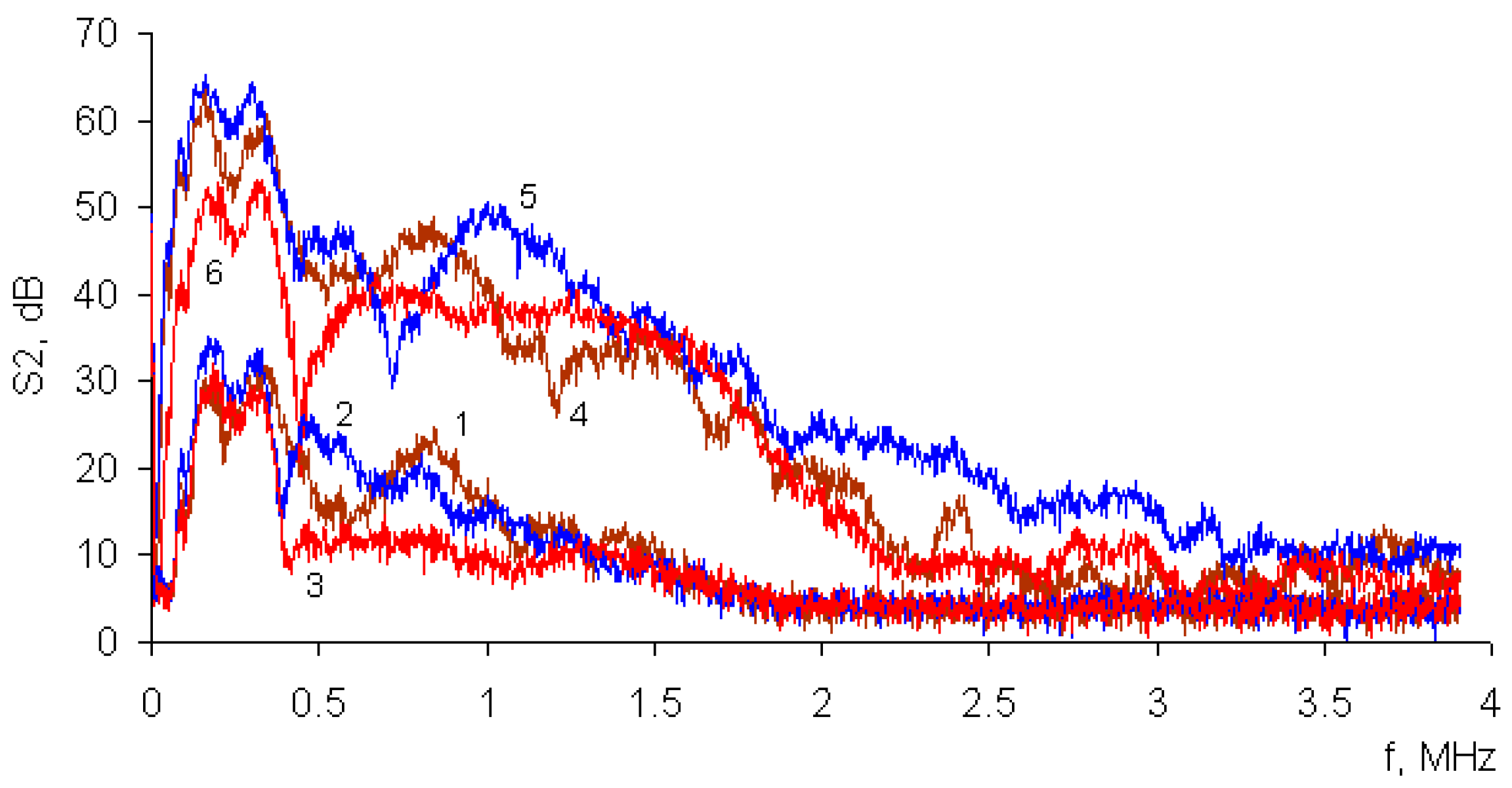

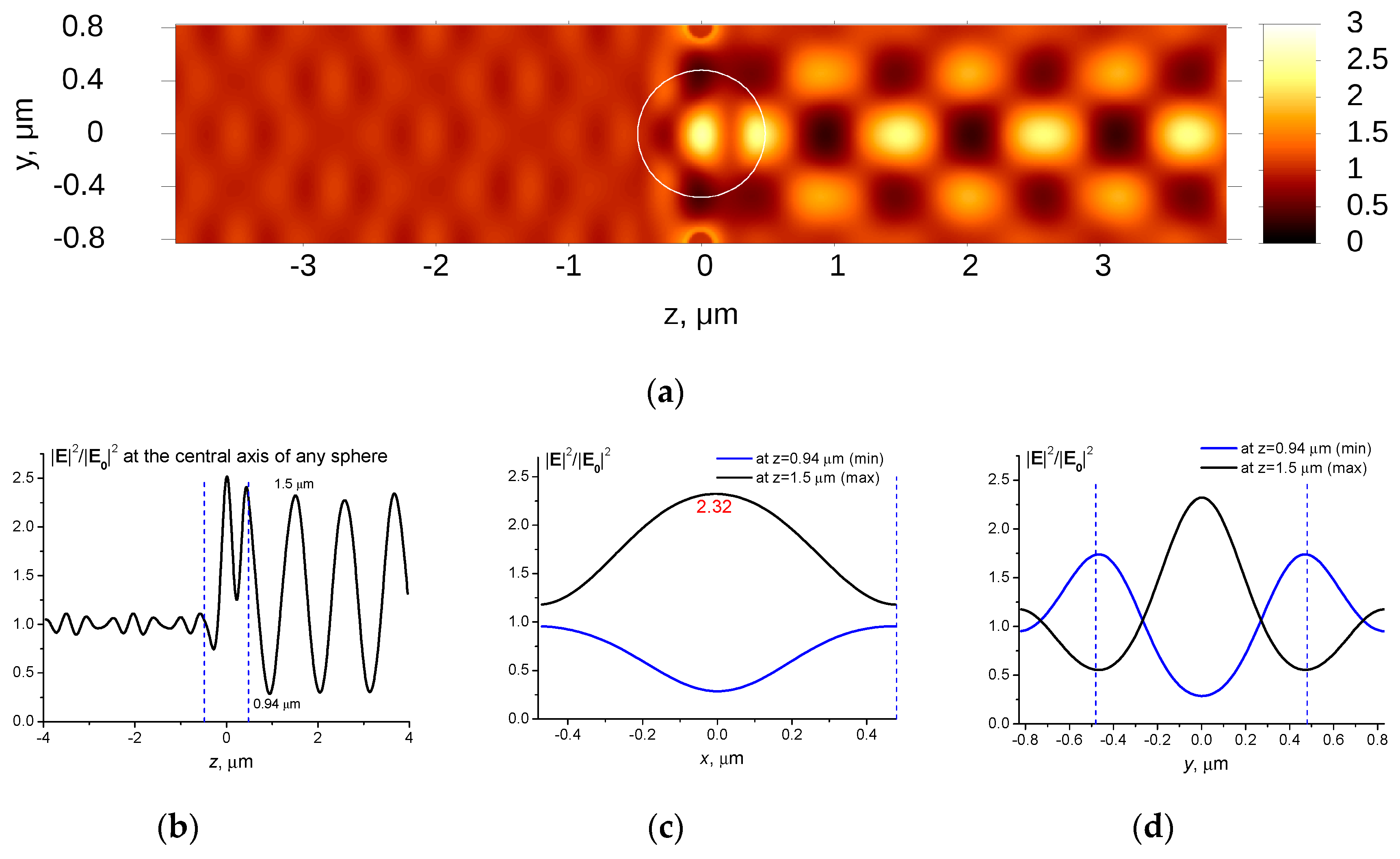
© 2019 by the authors. Licensee MDPI, Basel, Switzerland. This article is an open access article distributed under the terms and conditions of the Creative Commons Attribution (CC BY) license (http://creativecommons.org/licenses/by/4.0/).
Share and Cite
Bredikhin, V.I.; Kazakov, V.V. The Excitation of Ultrasound by Laser Radiation in Water Using an Optical Fiber Laser Converter with a 2D Colloidal Crystalline Coating. Coatings 2019, 9, 857. https://doi.org/10.3390/coatings9120857
Bredikhin VI, Kazakov VV. The Excitation of Ultrasound by Laser Radiation in Water Using an Optical Fiber Laser Converter with a 2D Colloidal Crystalline Coating. Coatings. 2019; 9(12):857. https://doi.org/10.3390/coatings9120857
Chicago/Turabian StyleBredikhin, Vladimir I., and Viacheslav V. Kazakov. 2019. "The Excitation of Ultrasound by Laser Radiation in Water Using an Optical Fiber Laser Converter with a 2D Colloidal Crystalline Coating" Coatings 9, no. 12: 857. https://doi.org/10.3390/coatings9120857
APA StyleBredikhin, V. I., & Kazakov, V. V. (2019). The Excitation of Ultrasound by Laser Radiation in Water Using an Optical Fiber Laser Converter with a 2D Colloidal Crystalline Coating. Coatings, 9(12), 857. https://doi.org/10.3390/coatings9120857





